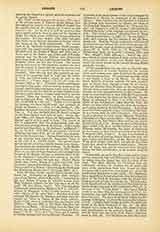

Le Quien, Michel, French historian and theologian, b. at Boulogne-sur-Mer, department of Pas-de-Calais, October 8, 1661; d. at Paris, March 12, 1733. He studied at Plessis College, Paris, and at twenty entered the Dominican convent of St-Germain, where he made his profession in 1682. Excepting occasional short absences he never left Paris. At the time of his death he was librarian of the convent in Rue St-Honore, a position which he had filled almost all his life, lending kindly assistance to the learned men who sought information on theology and ecclesiastical antiquity. Under the supervision of the celebrated Pere Marsollier he mastered the classical languages Arab, and Hebrew, to the detriment, it seems, of its mother-tongue.
His chief works, in chronological order, are: (I)”Defense du texte hebreu et de la version vulgate” (Paris, 1690), reprinted in Migne, “Scripturae Sacrae Cursus”, III (Paris, 1861), 1525-84. It is an answer to “L’antiquite des temps retablie” by the Cistercian Pezron, who took the text of the Septuagintas sole basis for his chronology. Pezron replied, and was again answered by LeQuien. (2) “Johannis Damasceniopera omnia”, Greek text with Latin translation (2 vols. fol., Paris, 1712) in Migne, “Patrologia Graeca”, XCIV-VI. To this fundamental edition he added excellent dissertations; a third volume, which was to have contained other works of the great Damascene and various studies on him, was never completed. (3)”Panoplia contra schisma Graecorum”, under the pseudonym of Stephanus de Altimura Ponticencis (Paris, 1718), a refutation of the Peri arch?s tou Papa “Mira of Patriarch Nectarius of Jerusalem, Le Quien maintained, with historical proofs derived chiefly from the Orient, the primacy of the pope. (4)”La nullite des ordinations anglicanes” (2 vols., Paris, 1725), and “La nullite des ordinations anglicanes demontree denouveau” (2 vols., Paris, 1730), against Le Courayer’s apology for Anglican Orders. (5) Various articles on archaeology and ecclesiastical history, published by Desmolets (Paris, 1726-31). (6)”Oriens christianusin quatuor patriarchatus digestus, in quo exhibentur Ecclesiae patriarchae caeterique praesules totius Orientis” published posthumously (3 vols., Paris, 1740).Le Quien contemplated issuing this work as early as1722, and had made a contract with the printer Simart (Revue de l’Orient latin, 1894, II, 190). In editing it, he used the notes of the Benedictine Sainte-Mar-thes, who had projected an “Orbis Christianus”, and had obligingly handed him over their notes on the Orient and Africa. The “Oriens Christianus”, as projected by Le Quien, was to comprise not only the hierarchy of the four Greek and Latin patriarchates of Constantinople, Alexandria, Antioch, and Jerusalem, and that of the Jacobite, Melchite, Nestorian, Maronite, and Armenian patriarchates, but also the Greek and Latin texts of the various “Notitiae episcopatuum”, a catalogue of the Eastern and African monasteries, and also the hierarchy of the African Church. The last three parts of this gigantic project were set aside by Le Quien’s literary heirs. As to the “Notitiae episcopatuum”, the loss is unimportant; the learned Dominican had not a very clear concept of the work called for by the editing of this text. His notes on Christian Africa and its monasteries have never been used, at least in their entirety. (7)”Abrege de l’histoire de Boulogne-sur-Mer et de ses comtes” in Desmolets, “Memoires de litterature”, X (Paris, 1749), 36-112.
S. VAILHE

